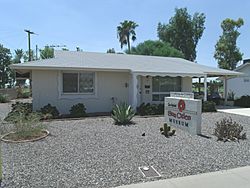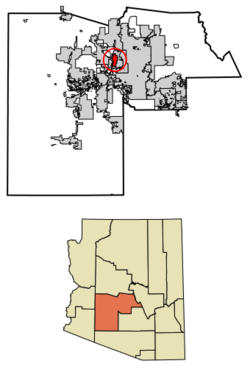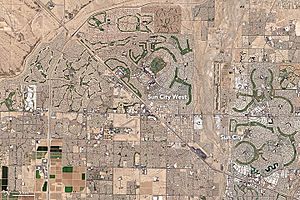Sun City, Arizona facts for kids
Quick facts for kids
Sun City, Arizona
|
||
|---|---|---|

The Sun City DEVCO Model #1
|
||
|
||

Location in Maricopa County, Arizona
|
||
| Country | United States | |
| State | Arizona | |
| County | Maricopa | |
| Area | ||
| • Total | 14.59 sq mi (37.80 km2) | |
| • Land | 14.42 sq mi (37.35 km2) | |
| • Water | 0.17 sq mi (0.45 km2) | |
| Elevation | 1,168 ft (356 m) | |
| Population
(2020)
|
||
| • Total | 39,931 | |
| • Density | 2,769.14/sq mi (1,069.16/km2) | |
| Time zone | UTC-7 (Mountain (MST)) | |
| ZIP codes |
85300-85399
|
|
| Area code(s) | 623 | |
| FIPS code | 04-70320 | |
| GNIS feature ID | 2410022 | |

Sun City is a special kind of community in Maricopa County, Arizona, United States. It's not officially a city, but it's a large area where many people live. It is part of the bigger Phoenix metropolitan area.
In 2020, about 39,931 people lived in Sun City. It has a nearby community called Sun City West. Both Sun City and Sun City West are known as places where many older adults live after they retire. They are also popular with "snowbirds" – people who move to warmer places like Arizona during the winter.
Contents
History of Sun City
How Sun City Began
Sun City started in June 1959. A company called Del E. Webb Development Co. bought a huge piece of land, about 20,000 acres, from the J.G. Boswell Company. This land used to be two ranches. The plan was to build a brand-new community just for retired people.
The Grand Opening
Sun City officially opened its doors on January 1, 1960. It had five different types of homes, a shopping center, a fun recreation center, and even a golf course. The opening weekend was a huge success! About 100,000 people came to visit, which was ten times more than expected. This big event was even featured in Time magazine.
The community was built where an old, almost empty town called Marinette used to be. At first, it was called the Marinette Retirement Community. But then, the developer, Del Webb, held a contest to choose a new name. The winner would even get a house! The name "Sun City" was chosen, and it stuck.
Growing Over the Years
The developer, Del E. Webb, kept expanding Sun City. His company also built other retirement communities in sunny places across the country. Some of these include Sun City West (built in the late 1970s), Sun City Grand (in the late 1990s), Sun City Anthem (in 1999), and Sun City Festival (in 2006).
Unique Street Design
If you look at a map of Sun City, you'll notice something cool about its streets. They are mostly designed in big circles, like four main pinwheels.
Geography and Climate
Where is Sun City?
Sun City is located about 16 miles (26 km) northwest of downtown Phoenix. It is surrounded by other cities. To the north, east, and south, it borders Peoria. To the southwest, it's next to Youngtown. To the west, you'll find El Mirage, and to the northwest, it's close to Surprise.
The total area of Sun City is about 14.6 square miles (37.8 square kilometers). Most of this area is land, with a small part being water.
Sun City's Weather
Sun City has a hot desert climate. This means it gets very hot and sunny for most of the year, especially in summer. Winters are mild and pleasant. It doesn't rain very much here.
| Climate data for Youngtown, Arizona, 1991–2020 normals, extremes 1964–present | |||||||||||||
|---|---|---|---|---|---|---|---|---|---|---|---|---|---|
| Month | Jan | Feb | Mar | Apr | May | Jun | Jul | Aug | Sep | Oct | Nov | Dec | Year |
| Record high °F (°C) | 87 (31) |
89 (32) |
98 (37) |
104 (40) |
113 (45) |
122 (50) |
122 (50) |
116 (47) |
114 (46) |
108 (42) |
95 (35) |
84 (29) |
122 (50) |
| Mean maximum °F (°C) | 77.8 (25.4) |
81.0 (27.2) |
89.8 (32.1) |
98.5 (36.9) |
105.3 (40.7) |
112.2 (44.6) |
114.4 (45.8) |
112.8 (44.9) |
108.4 (42.4) |
99.9 (37.7) |
87.6 (30.9) |
76.2 (24.6) |
115.5 (46.4) |
| Mean daily maximum °F (°C) | 65.4 (18.6) |
68.9 (20.5) |
76.5 (24.7) |
84.1 (28.9) |
92.9 (33.8) |
102.2 (39.0) |
104.9 (40.5) |
103.6 (39.8) |
98.4 (36.9) |
87.0 (30.6) |
73.9 (23.3) |
63.8 (17.7) |
85.1 (29.5) |
| Daily mean °F (°C) | 53.3 (11.8) |
56.4 (13.6) |
62.7 (17.1) |
69.5 (20.8) |
78.3 (25.7) |
87.2 (30.7) |
92.3 (33.5) |
91.4 (33.0) |
85.4 (29.7) |
73.2 (22.9) |
60.8 (16.0) |
52.0 (11.1) |
71.9 (22.2) |
| Mean daily minimum °F (°C) | 41.1 (5.1) |
43.8 (6.6) |
48.9 (9.4) |
54.8 (12.7) |
63.6 (17.6) |
72.2 (22.3) |
79.7 (26.5) |
79.2 (26.2) |
72.5 (22.5) |
59.5 (15.3) |
47.7 (8.7) |
40.2 (4.6) |
58.6 (14.8) |
| Mean minimum °F (°C) | 32.1 (0.1) |
35.5 (1.9) |
40.4 (4.7) |
46.1 (7.8) |
53.9 (12.2) |
64.0 (17.8) |
71.5 (21.9) |
71.4 (21.9) |
63.1 (17.3) |
49.3 (9.6) |
37.4 (3.0) |
30.8 (−0.7) |
29.4 (−1.4) |
| Record low °F (°C) | 20 (−7) |
24 (−4) |
24 (−4) |
32 (0) |
38 (3) |
51 (11) |
62 (17) |
54 (12) |
48 (9) |
35 (2) |
28 (−2) |
21 (−6) |
20 (−7) |
| Average precipitation inches (mm) | 0.98 (25) |
1.25 (32) |
1.03 (26) |
0.29 (7.4) |
0.11 (2.8) |
0.03 (0.76) |
0.84 (21) |
0.97 (25) |
0.74 (19) |
0.59 (15) |
0.61 (15) |
0.90 (23) |
8.34 (212) |
| Average precipitation days | 3.5 | 4.0 | 3.5 | 1.5 | 1.0 | 0.4 | 2.9 | 3.7 | 2.4 | 2.2 | 1.9 | 3.8 | 30.8 |
| Source: NOAA | |||||||||||||
Population of Sun City
| Historical population | |||
|---|---|---|---|
| Census | Pop. | %± | |
| 1970 | 13,670 | — | |
| 1980 | 40,505 | 196.3% | |
| 1990 | 38,126 | −5.9% | |
| 2000 | 38,309 | 0.5% | |
| 2010 | 37,499 | −2.1% | |
| 2020 | 39,931 | 6.5% | |
| source: | |||
Sun City is mostly home to older adults. In 2000, about 79.8% of the people living there were 65 years old or older. Only a very small number of households had children under 18 living with them. The average age of people in Sun City was 75 years old.
Fun and Activities
Sun City has many places for fun and staying active!
- Golf Courses: There are eight golf courses where people can play.
- Recreation Centers: Sun City has seven recreation centers. These places offer different activities and facilities for residents.
- Sun Bowl Amphitheatre: This is a large outdoor theater where concerts and other events are held.
- Lawn Bowling: Sun City has four places for lawn bowling, which is a sport similar to bowling but played on a lawn.
- Former Baseball Stadium: There used to be a baseball stadium called Sun City Stadium. It opened in 1971 and was used for spring training by the Milwaukee Brewers baseball team from 1973 to 1985. Other teams also played there. The stadium was taken down in 1995.
Getting Around Sun City
You can get around Sun City using Valley Metro Bus routes 106 and 138. These buses help people travel within the community and to nearby areas.
Images for kids
-
Plaque reads: "Sun City Sundial /One of the largest /Horizontal Sundials in America /Gnomon: 36' high, 64' long /Constructed 1973 /(Renovated 2011)"
See also
 In Spanish: Sun City (Arizona) para niños
In Spanish: Sun City (Arizona) para niños










